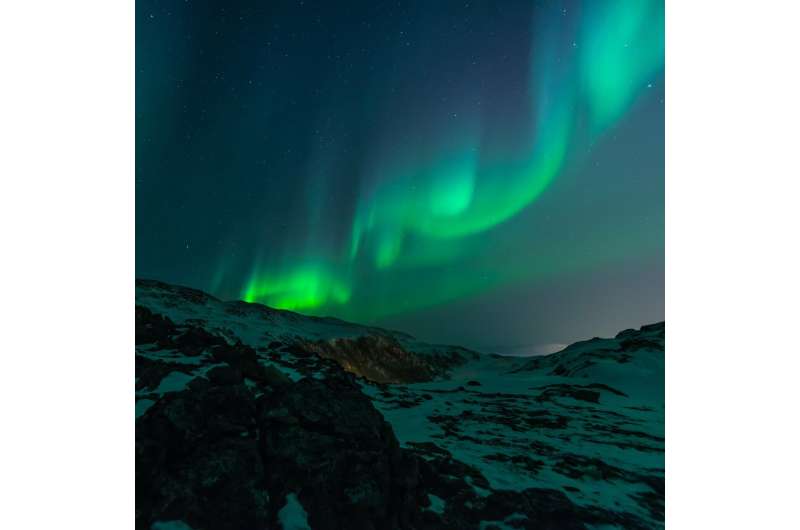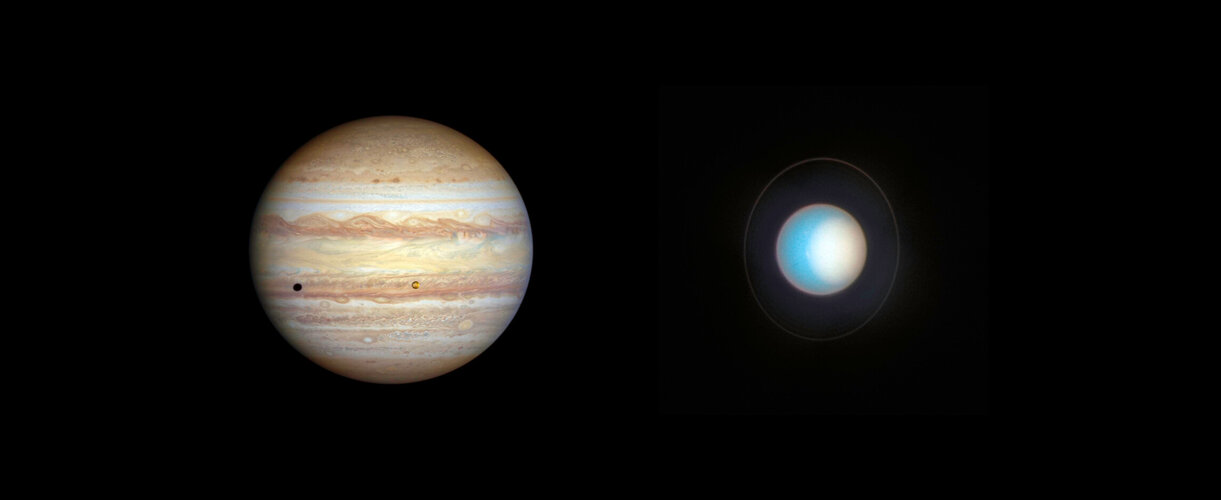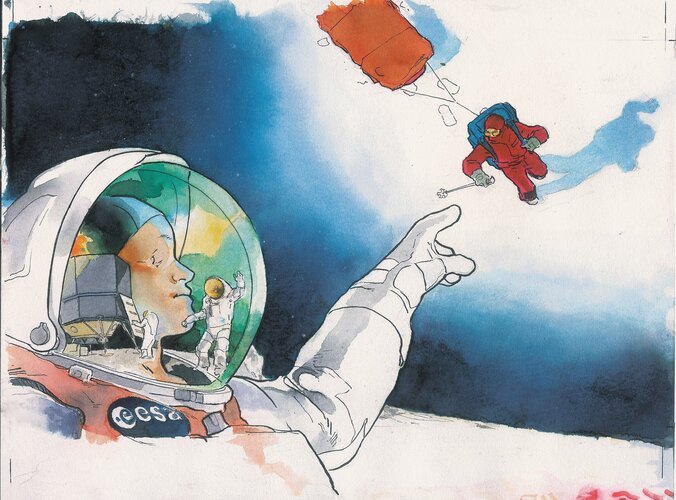Sweden's sky lights up with northern lights research
Thursday, 23 March 2023 19:15
Scientists in Sweden put on a light show in the night sky on Thursday, releasing material from a sounding rocket to research the spectacular northern lights phenomena.
The northern lights, also known as aurora borealis or polar lights, appear as swathes of blue, green and purple lights flickering and dancing across the sky.
They can occasionally be seen across the Arctic on clear nights.
Researchers at the Swedish Institute of Space Physics sent up the rocket from the Esrange Space Center in the country's far north, releasing materials similar to those in fireworks into the sky at an altitude of between 100-200 kilometers (62-124 miles).
Waves of greenish-white lights could be seen across the dark sky just after 1830 GMT above the northern Swedish town of Kiruna and within a 200-kilometer radius.
Somewhat less spectacular than the real northern lights, the experiment ended up blocking out a real aurora borealis occurring naturally.
The experiment was part of aurora research aimed at helping scientists improve near-space weather forecasts to protect satellites and critical infrastructures.
"People nowadays cannot imagine life without GPS, without TV, without satellite TV, without mobile phones and so on.
Hubble monitors changing weather and seasons on Jupiter and Uranus
Thursday, 23 March 2023 13:00
Ever since its launch in 1990, the NASA/ESA Hubble Space Telescope has been an interplanetary weather observer, keeping an eye on the ever-changing atmospheres of the largely gaseous outer planets. And it’s an unblinking eye that allows Hubble’s sharpness and sensitivity to monitor a kaleidoscope of complex activities over time. Today new images are shared of Jupiter and Uranus.
Media information session from ESA’s 315th Council
Thursday, 23 March 2023 13:00 Video:
01:03:07
Video:
01:03:07
Watch the replay of the media information session to hear about further transformation measures and ambitious, new ideas for space exploration following ESA's 315th Council, taking place in the freshly renovated ESA HQ Nikis building in Paris.
ESA Director General Josef Aschbacher and ESA Council Chair Anna Rathsman will cover the following topics: the implementation steps of the results of CM22, including the transformation of ESA to be fit for the future, the Space Summit planned for November 2023, as well as the public release of certain official ESA documents. Moreover, the final report and recommendations of the
Independent advisory group presents report on European space revolution to ESA
Thursday, 23 March 2023 11:07
First 3D-printed rocket lifts off but fails to reach orbit
Thursday, 23 March 2023 10:05 The world's first 3D-printed rocket launched successfully on Wednesday, marking a step forward for the California company behind the innovative spacecraft, though it failed to reach orbit.
Billed as less costly to produce and fly, the unmanned Terran 1 rocket launched from Cape Canaveral, Florida at 11:25 pm (0325 GMT Thursday) but suffered an "anomaly" during second-stage separation as it
The world's first 3D-printed rocket launched successfully on Wednesday, marking a step forward for the California company behind the innovative spacecraft, though it failed to reach orbit.
Billed as less costly to produce and fly, the unmanned Terran 1 rocket launched from Cape Canaveral, Florida at 11:25 pm (0325 GMT Thursday) but suffered an "anomaly" during second-stage separation as it First results from ESO telescopes on the aftermath of DART's asteroid impact
Thursday, 23 March 2023 10:05 Using ESO's Very Large Telescope (VLT), two teams of astronomers have observed the aftermath of the collision between NASA's Double Asteroid Redirection Test (DART) spacecraft and the asteroid Dimorphos. The controlled impact was a test of planetary defence, but also gave astronomers a unique opportunity to learn more about the asteroid's composition from the expelled material.
On 26 Septe
Using ESO's Very Large Telescope (VLT), two teams of astronomers have observed the aftermath of the collision between NASA's Double Asteroid Redirection Test (DART) spacecraft and the asteroid Dimorphos. The controlled impact was a test of planetary defence, but also gave astronomers a unique opportunity to learn more about the asteroid's composition from the expelled material.
On 26 Septe Surprisingly simple explanation for the alien comet 'Oumuamua's weird orbit
Thursday, 23 March 2023 10:05 In 2017, a mysterious comet dubbed 'Oumuamua fired the imaginations of scientists and the public alike. It was the first known visitor from outside our solar system, it had no bright coma or dust tail, like most comets, and a peculiar shape - something between a cigar and a pancake - and its small size more befitted an asteroid than a comet.
But the fact that it was accelerating away from
In 2017, a mysterious comet dubbed 'Oumuamua fired the imaginations of scientists and the public alike. It was the first known visitor from outside our solar system, it had no bright coma or dust tail, like most comets, and a peculiar shape - something between a cigar and a pancake - and its small size more befitted an asteroid than a comet.
But the fact that it was accelerating away from NRO awards contracts to BlackSky and Planet Labs for hyperspectral capabilities
Thursday, 23 March 2023 10:05 The National Reconnaissance Office (NRO) has awarded contracts to BlackSky Technology and Planet Labs Federal for the exploration of commercial hyperspectral image capabilities under the Strategic Commercial Enhancements (SCE) Broad Agency Announcement (BAA) program.
BlackSky Technology, a geospatial intelligence solutions provider, has been selected for a multi-stage SCE BAA framework stu
The National Reconnaissance Office (NRO) has awarded contracts to BlackSky Technology and Planet Labs Federal for the exploration of commercial hyperspectral image capabilities under the Strategic Commercial Enhancements (SCE) Broad Agency Announcement (BAA) program.
BlackSky Technology, a geospatial intelligence solutions provider, has been selected for a multi-stage SCE BAA framework stu NASA seeks student solutions for managing Moon landing dust cloud
Thursday, 23 March 2023 10:05 Huntsville AL (SPX) Mar 23, 2023
As NASA and industry partners develop new human landing systems to transport astronauts from lunar orbit to the Moon's surface and back as part of Artemis, the agency is asking university students to investigate solutions to one particularly dusty aspect of landing spacecraft on the lunar surface.
NASA's new Human Lander Challenge invites college students
Huntsville AL (SPX) Mar 23, 2023
As NASA and industry partners develop new human landing systems to transport astronauts from lunar orbit to the Moon's surface and back as part of Artemis, the agency is asking university students to investigate solutions to one particularly dusty aspect of landing spacecraft on the lunar surface.
NASA's new Human Lander Challenge invites college students Waves and a Rock: Sols 3778-3779
Thursday, 23 March 2023 10:05 Monday's planned drive positioned Curiosity with a new workspace to investigate. We have left the Marker Band, with Natalie's blog nicely summarizing our campaign there. As a physicist and spectroscopist by training, I find myself looking more at the analytical data, in particular X-ray fluorescence data, acquired on rocks, than the rocks themselves. But there was something about the primary roc
Monday's planned drive positioned Curiosity with a new workspace to investigate. We have left the Marker Band, with Natalie's blog nicely summarizing our campaign there. As a physicist and spectroscopist by training, I find myself looking more at the analytical data, in particular X-ray fluorescence data, acquired on rocks, than the rocks themselves. But there was something about the primary roc Hunting Venus 2.0: Scientists sharpen their sights
Thursday, 23 March 2023 10:05 With the first paper compiling all known information about planets like Venus beyond our solar system, scientists are the closest they've ever been to finding an analog of Earth's "twin."
If they succeed in locating one, it could reveal valuable insights into Earth's future, and our risk of developing a runaway greenhouse climate as Venus did.
Scientists who wrote the paper began wit
With the first paper compiling all known information about planets like Venus beyond our solar system, scientists are the closest they've ever been to finding an analog of Earth's "twin."
If they succeed in locating one, it could reveal valuable insights into Earth's future, and our risk of developing a runaway greenhouse climate as Venus did.
Scientists who wrote the paper began wit Searching for life with space dust
Thursday, 23 March 2023 10:05 Following enormous collisions, such as asteroid impacts, some amount of material from an impacted world may be ejected into space. This material can travel vast distances and for extremely long periods of time. In theory this material could contain direct or indirect signs of life from the host world, such as fossils of microorganisms. And this material could be detectable by humans in the near
Following enormous collisions, such as asteroid impacts, some amount of material from an impacted world may be ejected into space. This material can travel vast distances and for extremely long periods of time. In theory this material could contain direct or indirect signs of life from the host world, such as fossils of microorganisms. And this material could be detectable by humans in the near China launches carrier rocket for satellite installation
Thursday, 23 March 2023 10:05 China launched a Kuaizhou 1A carrier rocket on Wednesday afternoon at the Jiuquan Satellite Launch Center in the country's northwestern desert, placing four meteorological satellites in orbit, according to China Aerospace Science and Industry Corp.
The State-owned company said in a release that the solid-propellant rocket blasted off at 5:09 pm from its launch vehicle and then placed four
China launched a Kuaizhou 1A carrier rocket on Wednesday afternoon at the Jiuquan Satellite Launch Center in the country's northwestern desert, placing four meteorological satellites in orbit, according to China Aerospace Science and Industry Corp.
The State-owned company said in a release that the solid-propellant rocket blasted off at 5:09 pm from its launch vehicle and then placed four A common thread linking subatomic color glass condensate and massive black holes
Thursday, 23 March 2023 10:05 Physicists have discovered a remarkable correspondence between dense states of gluons-the gluelike carriers of the strong nuclear force within atomic nuclei-and enormous black holes in the cosmos. The dense walls of gluons, known as a color glass condensate (CGC), are generated in collisions of atomic nuclei. This CGC measures a mere 10-19 kilometers across-less than a billionth of a kilometer.
Physicists have discovered a remarkable correspondence between dense states of gluons-the gluelike carriers of the strong nuclear force within atomic nuclei-and enormous black holes in the cosmos. The dense walls of gluons, known as a color glass condensate (CGC), are generated in collisions of atomic nuclei. This CGC measures a mere 10-19 kilometers across-less than a billionth of a kilometer. Metaspectral Selected to join leading Australian Space Program
Thursday, 23 March 2023 10:05 Metaspectral, a remote sensing software company advancing computer vision using deep learning and hyperspectral imagery, is announcing that it has been selected to join Venture Catalyst Space.
Venture Catalyst Space is a leading commercial space accelerator and incubator program delivered by the University of South Australia's Innovation and Collaboration Centre (ICC) and is funded by the
Metaspectral, a remote sensing software company advancing computer vision using deep learning and hyperspectral imagery, is announcing that it has been selected to join Venture Catalyst Space.
Venture Catalyst Space is a leading commercial space accelerator and incubator program delivered by the University of South Australia's Innovation and Collaboration Centre (ICC) and is funded by the 
